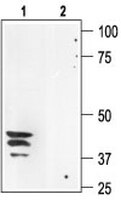178613 Sigma-AldrichAnti-Aquaporin 3 (275-292) Rabbit pAb
Anti-Aquaporin 3 (275-292), rabbit polyclonal, recognizes the ~40 and ~29 kDa forms of aquaporin-3 in rat kidney membrane. It is validated for Western blotting and immunohistochemistry.
More>> Anti-Aquaporin 3 (275-292), rabbit polyclonal, recognizes the ~40 and ~29 kDa forms of aquaporin-3 in rat kidney membrane. It is validated for Western blotting and immunohistochemistry. Less<<Sinónimos: Anti-AQP3, Anti-GLIP
Productos recomendados
Descripción
| Replacement Information |
|---|
Tabla espec. clave
| Species Reactivity | Host | Antibody Type |
|---|---|---|
| R | Rb | Polyclonal Antibody |
| References | |
|---|---|
| References | Echevarria, M., et al. 1994. Proc. Natl. Acad. Sci. USA 91, 10997. Ishibashi, K., et al. 1994. Proc. Natl. Acad. Sci. USA 91, 6269. |
| Product Information | |
|---|---|
| Form | Lyophilized |
| Formulation | 50 µl antibody lyophilized from PBS, 1% BSA, 5% sucrose, pH. 7.4 and 40 µg AQP3275-292 control peptide lyophilized from PBS. |
| Preservative | ≤0.1% sodium azide |
| Quality Level | MQ100 |
| Physicochemical Information |
|---|
| Dimensions |
|---|
| Materials Information |
|---|
| Toxicological Information |
|---|
| Safety Information according to GHS |
|---|
| Safety Information |
|---|
| Product Usage Statements |
|---|
| Packaging Information |
|---|
| Transport Information |
|---|
| Supplemental Information |
|---|
| Specifications |
|---|
| Global Trade Item Number | |
|---|---|
| Número de referencia | GTIN |
| 178613 | 0 |
Documentation
Anti-Aquaporin 3 (275-292) Rabbit pAb Certificados de análisis
| Cargo | Número de lote |
|---|---|
| 178613 |
Referencias bibliográficas
| Visión general referencias |
|---|
| Echevarria, M., et al. 1994. Proc. Natl. Acad. Sci. USA 91, 10997. Ishibashi, K., et al. 1994. Proc. Natl. Acad. Sci. USA 91, 6269. |









